“We wanted to get our world-building, full-throttle creative mojo back” Simon Furman and Geoff Senior on new comic To The Death
From its explosive opening scene which sees a bunch of grizzled mercs battling aliens on a battle ravaged planet then you know you are in for some hard hitting action in To The Death. But what else would you expect from Simon Furman and Geoff Senior, creators or Death’s Head and Dragon’s Claws. We caught up with Simon and Geoff to find out why they have teamed up once more, and the secret to writing a great action comic!
You guys aren’t strangers to working together, so what was it about the concept of To The Death that made you want to work together again?
Geoff Senior: Simon and I have been friends and work colleagues for more years than I care to remember. We’d meet up on a pretty regular basis for a beer and chat. The prospect of doing something in the comics genre again was always on the cards and it felt like a good time to get something going.
Simon had the basics of ‘To The Death‘ (though don’t think it actually had a title at that point) flickering away beneath his shiny dome. We would chat about it and kick a few ideas around on what we wanted to do story wise. I’d been ‘out’ of comics for quite a while and it really felt time to get back on board and do what we enjoyed the most!
Simon Furman: Both of us wanted to create something – together – from the ground up again, get our world-building, full-throttle creative mojo back. A story, engaging characters, high stakes… and we wanted it to be ours. And that brought to mind Dragon’s Claws, which we’d co-created for Marvel UK back in the 80s. That had all the adrenaline-fuelled storytelling elements we both liked, with both of us on our A-game creatively speaking, so it worked as a loose template for our new series, which became To The Death.
And why opt for a creator owned vehicle rather than return to your familiar world of Transformers?
GS: Simply having ownership and control of our own story and characters. It was our choice and decision on all aspects of the story arc and character development and design. We’re old and experienced enough to oversee the project. Simon has many years of editorial and writing experience behind him and I equally on storytelling image breakdown and design. To The Death is our property
and we decide what to do and where to go with it, that’s a very satisfying feeling.
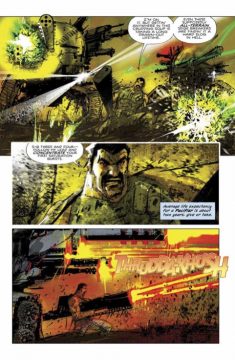 SF: The trouble with, say, a Dragon’s Claws or a Death’s Head, is that you put a lot of yourself into these projects and characters and in the end you don’t own them, and you’re forever waiting on whoever does to commission new series (and choose you to write/draw them). Most of all, we wanted to take control of whatever we spent a lot of man-hours creating, and be able to take it exactly where we wanted to go with it without oversight or other opinions.
SF: The trouble with, say, a Dragon’s Claws or a Death’s Head, is that you put a lot of yourself into these projects and characters and in the end you don’t own them, and you’re forever waiting on whoever does to commission new series (and choose you to write/draw them). Most of all, we wanted to take control of whatever we spent a lot of man-hours creating, and be able to take it exactly where we wanted to go with it without oversight or other opinions.
So often I’ve seen things get so far and then flounder, because there’s been a change of mind (or sometimes person) at the end of things. Our instincts with To The Death may turn out to be good or bad, right or wrong, but at least it would have been our instincts. And sure, maybe the knee-jerk way to go would have been to appeal to our Transformers/mech fanbase, but that just wasn’t firing us in the same way as something in the vein of Dragon’s Claws (with plenty of military muscle and gung-ho spirit and undercurrents/themes that relate to the world we live in, or at least its potential future).
Does the fact you have worked together so much in the past help you to push the boundaries further as you know each other’s strengths and how to push each other in new directions?
GS: We’re very comfortable with our creative partnership built up over many years, this makes the process smooth and enables us to push those boundaries naturally. Neither of us are too ‘precious’ and always open to suggestion on how to develop the story. The ‘Killatoa’ character came about during one of our pub meetings. I think we both saw the enjoyment in throwing a relentless almost indestructible character into the mix.
SF: It helps in as much as I know what Geoff likes to draw and what brings out the absolute best in him. So To The Death had to have pace, and action, and phenomenally high stakes. Geoff’s work is kinetic and visceral, and I wrote To The Death in screenplay format, which allowed him to dictate the flow and pace of the story more. And the digital format we used for its first release meant there were no page/panel constraints, and the series could evolve organically as it rolled out.
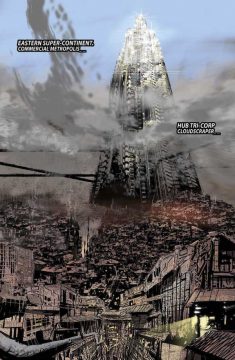
Unbound somewhat from the strictures of producing something for a company, we could make To The Death as sweeping, powerful and plain outrageous as we wanted. It’s more of a grand summer blockbuster action/sci-fi movie epic – with a defined beginning, middle and mind-blowing end – than a conventional comic series as such.
The issue starts with a real bang, and a long action sequence. Was it important to set the tone of the book with this all action start? And do you like writing/drawing those kinds of scenes?
SF: Both of us felt the need to ‘set out our stall’ right from the get-go. We could have spent time scene setting on Earth up front, but we wanted people left in no doubt to what they could expect from To The Death.
The opening is the series in a nutshell: crazy, bloody, over-the-top action with big guns and hard-bitten (but flawed) heroes, monstrous villains and far-flung alien worlds. Sure, there’s (much) more to the story than that, and hopefully it engages on several levels, but this is pure gut-level comic book storytelling. We just started as we meant to continue.
GS: I knew Simon would come up with a great action storyline and it was important to start off at a pace that would run through the 10 issues. I’ve always enjoyed drawing and storytelling action scenes. Simon kept the script quite loose and open to interpretation which suits the way we work together. We could develop the scenes as we went along and bounce ideas back and forth. I’m really pleased with how the plot unfolds and Simon has delivered a very epic and spectacular finale!
The story is much more than just a load of action scenes though, and has subplots involving evil corporations attempting to control the masses as well as a soldier away from his family. As real life becomes increasingly like a dystopian comic, is it more challenging to come up with these kinds of shocking futuristic concepts that feel fresh?!
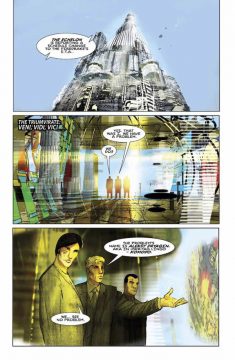
SF: It’s hard to be completely original and To The Death wears its influences boldly/proudly. But… to me, all sci-fi (all good sci-fi) is a warped mirror held up to society now. So stuff like mega-corporations increasingly being the real power in today’s world (and governments and nations marginalised as a consequence), our/their continued full-throttle depletion of the planet’s resources, and the addictive, immersive and de-sensitising nature of gaming… were things I felt had relevance to people now (but of course pushed to the nth degree).
But still this is just texture, a backdrop to the more personal/human level story we were telling about two fractured/clinging on families – Dryagin’s and Scourge Squadron itself.
Is it important to give your characters a sense of depth with a home life or family, in order to give them something to fight for?
SF: Absolutely. Our lead character, Aleksy Dryagin, is most definitely a flawed human being, and something of an anti-hero. But we still have to be rooting for him, and that means layering him with doubts and questions and regrets and everything in between. Humanising him to the point where we care, because we recognise one or more of those flaws in ourselves. Strip away that, and it becomes something closer to a shoot ‘em up computer game. We wanted people to invest in the story, in Dryagin, and the whole one person against the system/doomed tilt vibe of the story.
Geoff have you evolved or developed your style specifically for To The Death – it feels like the colours in particular are really over saturated and the artwork seems to mix up all kinds of digital elements as well as your line work?
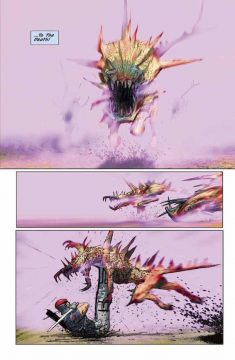
GS: As To The Death was initially a web based adventure with single panel images I approached it like a ‘shooting board’ . They were done at a high res as there was always a strong possibility that it would be re-formatted into a comic book. The breakdown of the storyline was up to me and became some 1400 or so frames!
My drawing /colouring technique was fast and loose, capturing the action and movement. I always feel the more you get bogged down in detail etc then that movement and ‘life’ doesn’t carry through. I used a few digital shortcuts to get certain details of buildings etc and made a few photoshop ‘brushes’ along the way.
The Firedrake ship used by Dryagin’s pacifiers is based around a Vulcan bomber of which I’ve always loved the delta wing shape. I drew it at various angles to give me chance to drop it in here and there as needed. More technically capable people would
probably have made a 3D model.
Strong colour is always important to me as I really wanted it to enhance the story and though set in a grim future I didn’t want it to look desaturated or bland. I always think if you’re going to colour then use them ! Actually the ‘Killatoa’ character has evolved colour wise from his initial appearances in the web version. That’s the beauty of having another pass over the frames before I reformat into comic book pages.
The book is released in a 10 part arc, with each volume having really high production values and longer page count. Was it important for you to create a really desirable and substantial product? And why did you choose to self publish rather than go to a publisher?
SF: One almost feeds into the other. By cutting out certain middle parties we had more available funds to pour into our overall production values. Almost from the outset, we knew we had to go to 48-page plus covers format, because breaking down the digital series into print seemed to need that amount of story content per issue (and we didn’t want 20 monthly issues). We also knew fairly early on that we wanted the 10-issues series to stand on its own, without the need for trade paperback or other collected editions. So the perfect bound ‘prestige’ format with card stock covers and a thin spine felt like the right (substantial) way to go.
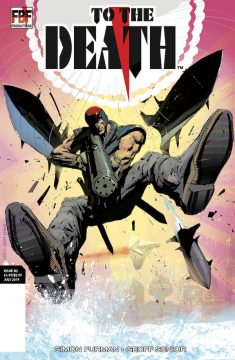
We may collect the series sometime, but not for the foreseeable, and working with Comic Toolbox (our publishing partners) and going direct to comic book stores has freed us up to have the entire series continually available/in-stock. So even if you come in at issue #4, you’ll be able to find issues #1-3. There’s no first, second printings etc with To The Death. It’s just continually out there in the world. We’re currently looking into the idea of slipcases to house your ten issues, almost negating the need for a TPB or collected edition.
You’re releasing it via Get My Comics and Comics Toolbox, can you tell us a bit about how that relationship came about, and what is so good about it for you as creators?
SF: What Comic Toolbox brings to the mix is a distinct hands-off approach on any creative element of To The Death but amazing professionalism and depth of knowledge/experience when it comes the logistics of supplying individuals and comic book stores. Effectively, they’re our publisher and distributor in one. But more than that they’re just on the same wavelength as Geoff and I, with the same passion for comics and creating comics, and their side of the ‘deal’ is just they can expand that portal for independent publishing further, opening it up for other creators by provided a working model of getting your creator-owned comic to market. When we launched at MCM this year, Comic Toolbox leant us a really businesslike air of professionalism. Generally, they free us up to do our creative thing, but equally they bring a knowledge and understanding of the comic book market to the mix that feeds back into the product itself.
You can purchase To The Death for £4.99 per issue from Get My Comics and you can discover more of Simon’s work at simonfurman.wordpress.com and see more of Geoff’s work at www.geoffsenior.com




October 9, 2025 @ 5:01 am
I can’t wait to share this with others. Watch equidia live tv — live horse racing, Quinté+ analysis, pronostics, replays, and results. HD streaming with expert commentary and a comprehensive programme guide.
December 20, 2025 @ 3:03 pm
Mit 7707 Zimmern mit Blick auf die Stadt liegt… Stratosphere Las Vegas befindet sich in der Nähe vom 5-Sterne-Hotel Fontainebleau Las Vegas und ist unter anderem in 12 Minuten fußläufig zu erreichen. Es liegt im Stadtteil Las Vegas Strip, in nur 450 Meter Entfernung von Madame Tussauds und ist somit ideal für…
Dieses außergewöhnliche Hotel bietet seinen Gästen eine Vielzahl an… Das Fontainebleau ist ein luxuriöses 5-Sterne-Hotel, das seinen Gästen ein unvergessliches Erlebnis inmitten des aufregenden Treibens des Las Vegas Strip bietet. Diese exklusive Unterkunft bietet nicht nur… Das Hotel Skylofts At Mgm Grand vereint modernen Luxus mit einmaligem Komfort und einem unvergesslichen Erlebnis in der glitzernden Stadt Las Vegas. Es liegt deshalb in der Verantwortung des Nutzers sicherzustellen, dass er die regionalen Vorschriften versteht und einhält.
Die Eröffnung der Riviera, zusammen mit The Dunes und den Royal Nevada Casino Resorts innerhalb eines Monats waren Gegenstand einer berühmten Ausgabe des Life Magazins, am 20. Die Riviera wurde zu einem der ältesten und bekanntesten Casino Resorts in Las Vegas Valley. Liberace schnitt das Eröffnungsband und wurde der erste ansässige Performer. Marx Brothers Harpo und Gummo hatten bei der Eröffnung Minderheitsbeteiligungen. Das Hotel hatte mehr als 2.100 Zimmer, weniger als die Hälfte davon in einem 23-stöckigen Turm. Es war zuletzt im Besitz der Las Vegas Convention and Visitors Authority, die beschloss, es abzureißen, um Platz für den Las Vegas Global Business District zu schaffen.
References:
https://online-spielhallen.de/tipico-casino-login-ihr-einfacher-zugang-zur-casinowelt/
December 26, 2025 @ 3:02 pm
A good casino should offer live chat and respond quickly to questions. Welcome bonuses are great, but what happens after that? When a site works with top providers like NetEnt, Evolution, or Pragmatic Play, you know you’re getting high-quality, fair games. Rocketplay ticks these boxes with a variety of Aussie-friendly options, plus fast cashouts starting from just one hour. Reliable casinos offer safe, fast, and familiar payment options. Rocketplay, for example, operates under a Curacao eGaming licence, which allows it to serve players in Australia legally and transparently.
All games available at RocketPlay are regularly audited by independent testing agencies to ensure fair play and random outcomes. It is crucial to choose a trustworthy casino to ensure a safe and reliable gaming experience. Introducing fast and anonymous crypto transactions with added bonuses for a perfect game. If you or someone you know has a gambling problem, seek help from a professional support service.
Get access to hundreds of pokies, live tables, and free spins when you create an account – all in a safe, mobile-friendly environment. Try real money gaming or find an available demo slot What is the process for taking funds out of the Rocketplay casino?
References:
https://blackcoin.co/black-jack-strategy-poker/
December 26, 2025 @ 9:57 pm
I’ve been using Neospin to play pokies ever since it was released in 2022 – it’s a very popular online casino here in Australia. The $500 VIP program entry and the missing table games section are just minor drawbacks in an otherwise top Australian online casino. After my pokies session, I tried a couple of unusual live casino games like Monopoly and Andah Bahar (just to take a break from the usual blackjack and roulette), and the experience was overall great. If a casino looks generic, it usually IS generic, and I’ve got nothing against mediocrity – but this is a list of the best online casinos in Australia after all. This means that online casinos cannot operate legally in Australia. We are a whole team working together to bring you updated picks of the best Australian online casinos based on their safety, payout history, software partners, and more.
These states have established regulatory frameworks that allow players to enjoy a wide range of online casino games legally and safely. As the legal status of online casinos in the US varies from state to state, it is imperative for players to keep abreast of both current and prospective legislation. Many top casino sites now offer mobile platforms with diverse game selections and user-friendly interfaces, making online casino gambling more accessible than ever. Access to a myriad of bonuses and promotions stands out as one of the key benefits of engaging in online casinos. The diverse range of games provided by online casinos is one of their most compelling features. Engaging in games at premier online casinos carries a plethora of advantages.
References:
https://blackcoin.co/39_best-vip-online-casino-2022_rewrite_1/
December 29, 2025 @ 5:35 am
online casino mit paypal
References:
https://www.revedesign.co.kr/bbs/board.php?bo_table=free&wr_id=319321
December 29, 2025 @ 6:00 am
paypal casinos online that accept
References:
https://joblinksolution.org/employer/online-casinos-that-accept-paypal-usa-high-5-casinos/